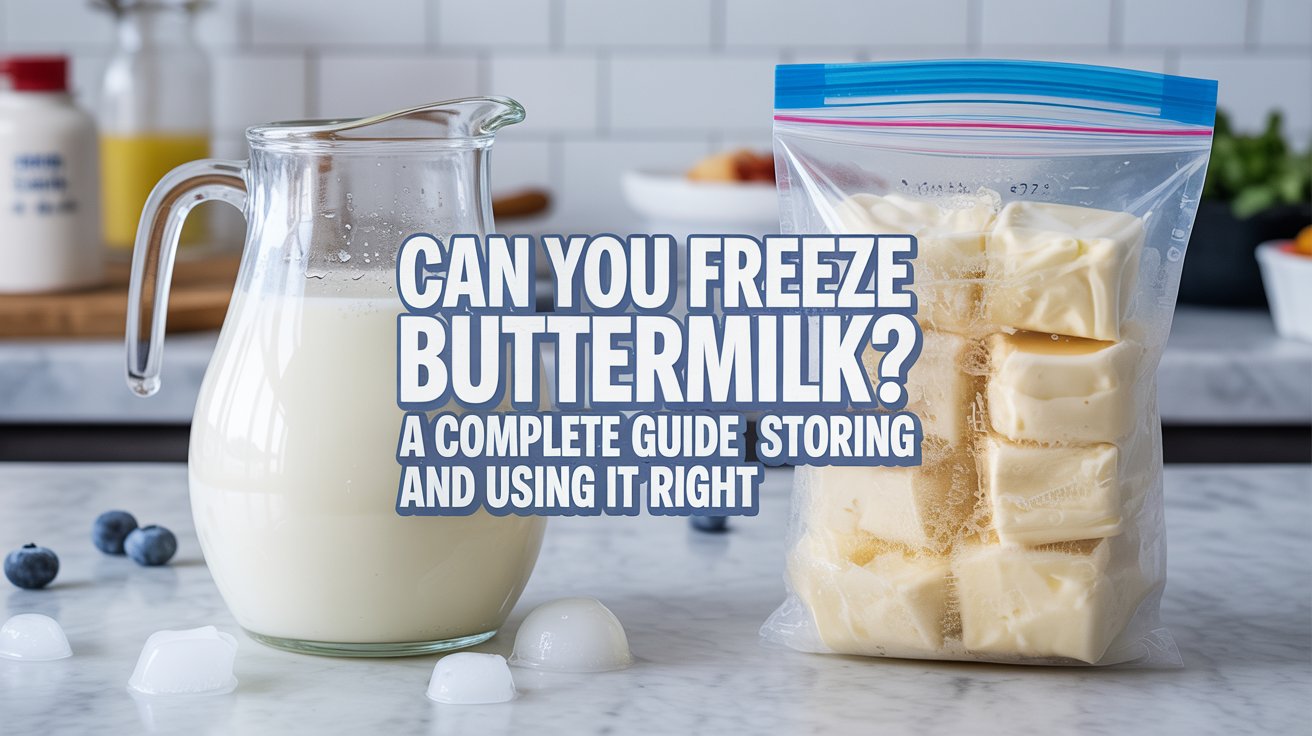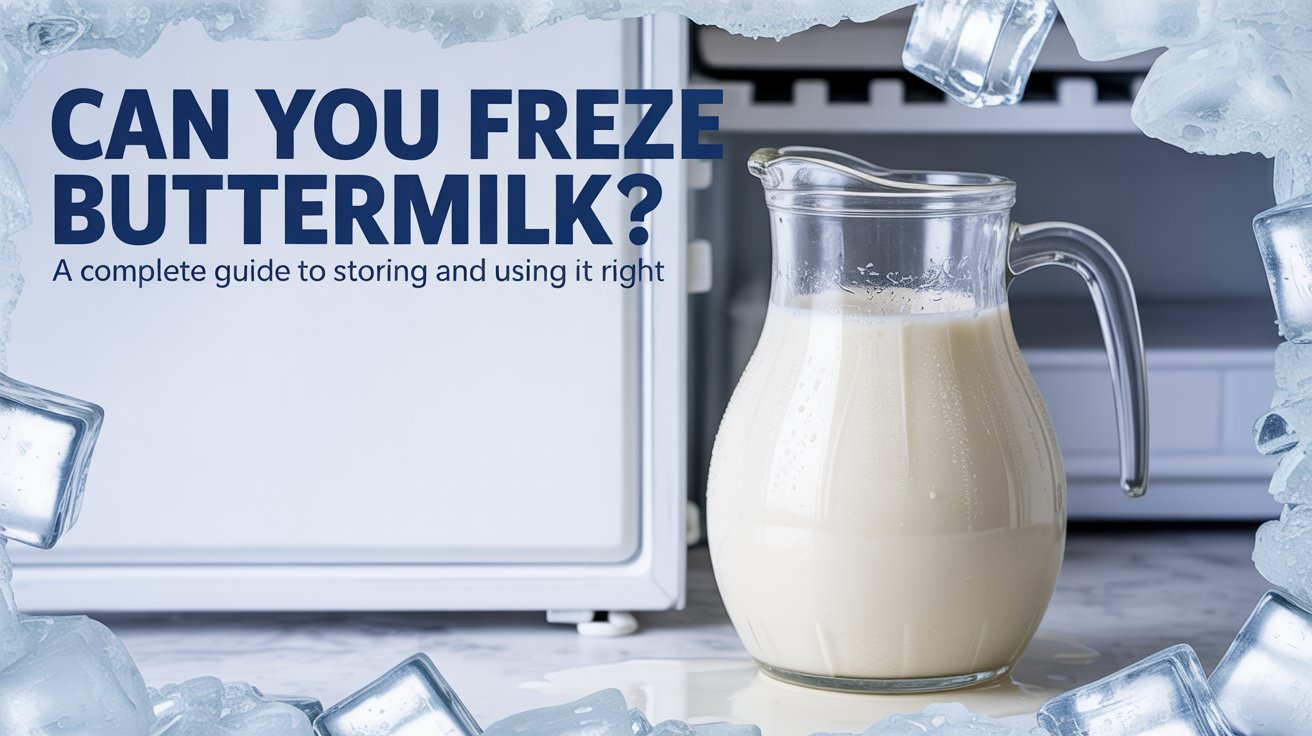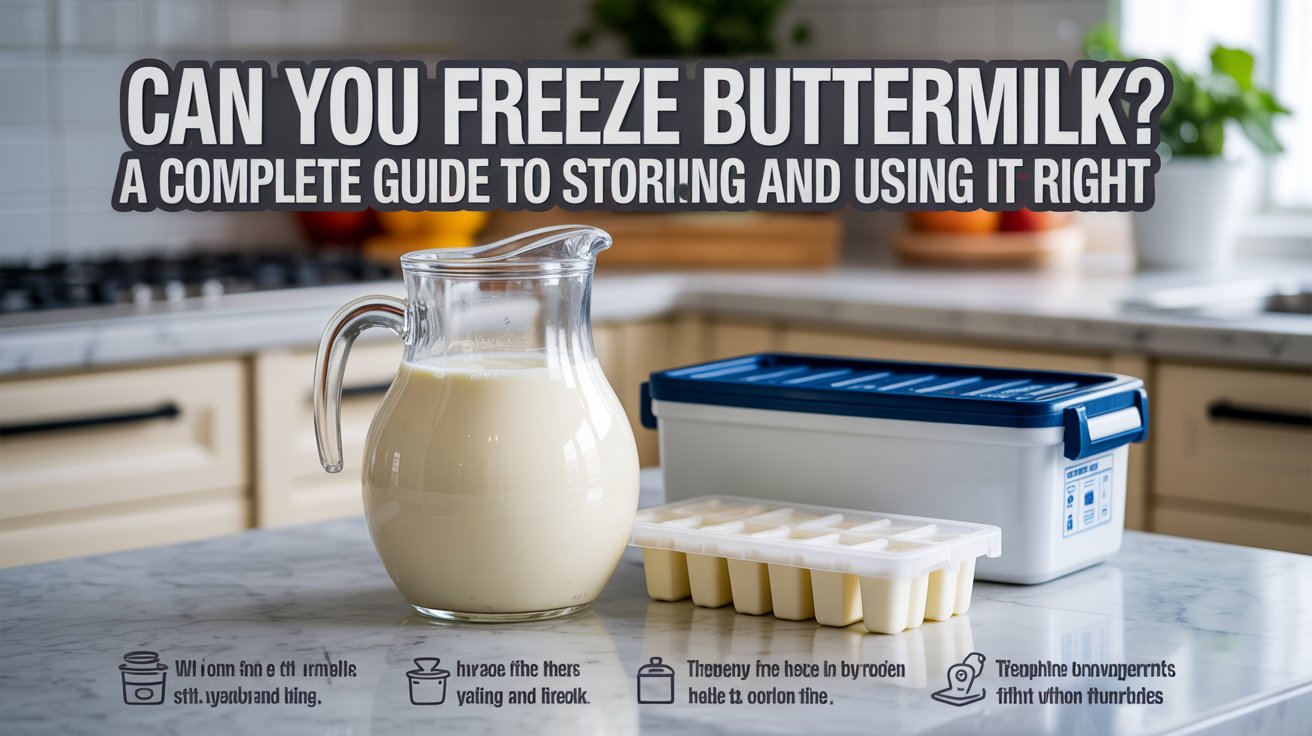If you’ve ever baked biscuits, pancakes, or cakes, chances are you’ve used buttermilk. But here’s the catch — most recipes don’t need the entire carton. So what do you do with the leftover buttermilk? Pour it down the drain? Absolutely not! The real question is — can you freeze buttermilk?
The short answer: Yes, you can! But like any dairy product, there’s a right way (and a wrong way) to freeze it. In this detailed guide, we’ll walk through everything you need to know — from freezing methods and thawing tips to creative ways to use frozen buttermilk.
What Is Buttermilk?
Buttermilk isn’t just sour milk — it’s a cultured dairy product with a tangy flavor and creamy texture. In the past, buttermilk referred to the tangy liquid that remained after butter was churned from cream. Nowadays, most store-bought buttermilk is made by fermenting milk with lactic acid bacteria, which gives it that signature tang and thickness.
Think of it as yogurt’s thinner, more versatile cousin — perfect for baking, marinating, or even salad dressings.
Why You Might Want to Freeze Buttermilk
Ever opened a carton of buttermilk for a single recipe and found yourself with half of it left over? You’re not alone. Buttermilk has a short shelf life — usually about two weeks when refrigerated. Freezing helps extend its life by several months, making it both convenient and economical.
Freezing buttermilk helps:
-
Reduce waste by preserving leftovers.
-
Save money by buying in bulk.
-
Ensure availability for future recipes.
Can You Really Freeze Buttermilk Safely?
Yes, you can safely freeze buttermilk without worrying about spoilage or losing its core properties. Freezing doesn’t affect the nutritional content, though it may slightly change the texture. Once thawed, it can appear a little grainy or separated — but don’t panic! A quick whisk or shake can easily restore its smooth consistency.
How Freezing Affects Buttermilk Texture and Taste

When buttermilk freezes, the water content forms ice crystals, causing a bit of separation between the liquid and solids. After thawing, it might look curdled — similar to milk that’s been left out too long.
However, this is purely visual. The flavor remains the same, and the consistency works perfectly in baked goods, marinades, and dressings.
Pro Tip: Avoid using thawed buttermilk in drinks or smoothies where texture matters most. Stick to cooking and baking recipes instead.
Best Ways to Freeze Buttermilk
Freezing buttermilk is simple, but the container you choose makes a difference. Here are a few proven methods:
-
Ice cube trays — great for portioning small amounts.
-
Muffin tins — ideal for ¼ to ½ cup servings.
-
Freezer-safe jars or bags — perfect for bulk storage.
Each method works depending on how you plan to use the buttermilk later.
Freezing Buttermilk in Ice Cube Trays
This is one of the easiest and most practical methods.
How to do it:
-
Pour buttermilk into ice cube trays, leaving a little space at the top.
-
Freeze for 4–6 hours until solid.
-
Remove the frozen cubes and place them into a clearly labeled freezer-safe bag for easy storage.
Why it works:
Each cube usually equals about 2 tablespoons — perfect for small recipes like pancakes or salad dressings.
Freezing Buttermilk in Jars or Containers
If you use buttermilk in larger recipes, freezing it in jars or containers makes more sense.
Steps:
-
Pour buttermilk into a clean, freezer-safe container.
-
Leave an inch of space at the top — buttermilk expands when frozen.
-
Seal tightly and label with the date.
Note: Avoid glass jars unless they’re labeled freezer-safe. Regular glass can crack under freezing temperatures.
How Long Can You Freeze Buttermilk?

Frozen buttermilk lasts up to three months without losing flavor or quality. After that, it may start to develop freezer burn or an off taste.
Tip: Always write the freezing date on the container — it’s easy to forget when that batch went in!
How to Thaw Frozen Buttermilk Correctly
The safest way to thaw buttermilk is in the refrigerator overnight. This method ensures even thawing and maintains quality.
If you’re short on time:
-
Place the container in a bowl of cold water for a few hours.
-
Never thaw buttermilk at room temperature — it can spoil quickly.
Once thawed, give it a good stir or shake to recombine the separated solids and liquid.
How to Use Thawed Buttermilk in Recipes
You can use thawed buttermilk in almost any recipe that calls for fresh buttermilk. Here are some delicious ideas:
-
Pancakes and waffles for that signature tang and fluffiness.
-
Biscuits and scones that rise beautifully.
-
Fried chicken marinades — the acidity tenderizes meat perfectly.
-
Cakes and muffins for a soft, moist crumb.
Just remember — thawed buttermilk may be slightly thinner, but it performs just as well.
Can You Refreeze Buttermilk After Thawing?
It’s not recommended. Once thawed, the structure of buttermilk changes. Refreezing can cause further separation and texture loss, making it less effective in recipes. Always freeze in small portions to avoid waste.
Creative Ways to Use Frozen Buttermilk
If you’ve stocked up, here are some fun ways to use it:
-
Add to mashed potatoes for a tangy twist.
-
Mix into soups or creamy sauces for extra richness.
-
Use in smoothies or milkshakes if you don’t mind a little texture change.
-
Make homemade ranch dressing using thawed buttermilk, herbs, and spices.
It’s like having a secret ingredient ready to enhance your dishes anytime.
Common Mistakes to Avoid When Freezing Buttermilk

Even simple processes have pitfalls. Here’s what to avoid:
-
Not labeling containers: You’ll forget the date.
-
Overfilling jars: Buttermilk expands as it freezes.
-
Thawing on the counter: Increases spoilage risk.
-
Using in drinks post-freezing: Texture may disappoint.
Avoid these, and your buttermilk will stay fresh and flavorful.
Storage Tips for Maximum Freshness
A little care goes a long way:
-
Store buttermilk in airtight containers to prevent freezer odors.
-
Use freezer bags for flexible storage.
-
Keep it at 0°F (-18°C) or below.
-
Use within three months for best results.
Following these tips ensures your buttermilk remains recipe-ready whenever you need it.
FAQs
1. Is it safe to freeze buttermilk without removing it from its original carton?
It’s better not to. The carton isn’t airtight and may burst as the liquid expands. Transfer it to freezer-safe containers instead.
2. How do you know if buttermilk has gone bad after freezing?
If it smells sour (beyond the normal tang), looks discolored, or has mold, discard it immediately.
3. Can you freeze homemade buttermilk?
Yes, homemade buttermilk freezes just as well as store-bought versions. Just ensure it’s stored in a clean, airtight container.
4. Does freezing affect the acidity of buttermilk?
No, freezing doesn’t change its acidity. The tangy flavor remains intact even after thawing.
5. What’s the best substitute if I don’t have buttermilk?
You can mix 1 cup of milk with 1 tablespoon of lemon juice or vinegar, let it sit for 10 minutes, and use it as a quick buttermilk substitute.
Final Thoughts
So, can you freeze buttermilk? Absolutely — and you should! It’s a simple, smart way to save money, reduce waste, and always have this versatile ingredient on hand. Whether you’re baking a fluffy batch of biscuits or whipping up creamy dressings, frozen buttermilk works like a charm once properly thawed.
Think of your freezer as a time capsule — preserving flavor and freshness for your next culinary masterpiece.








